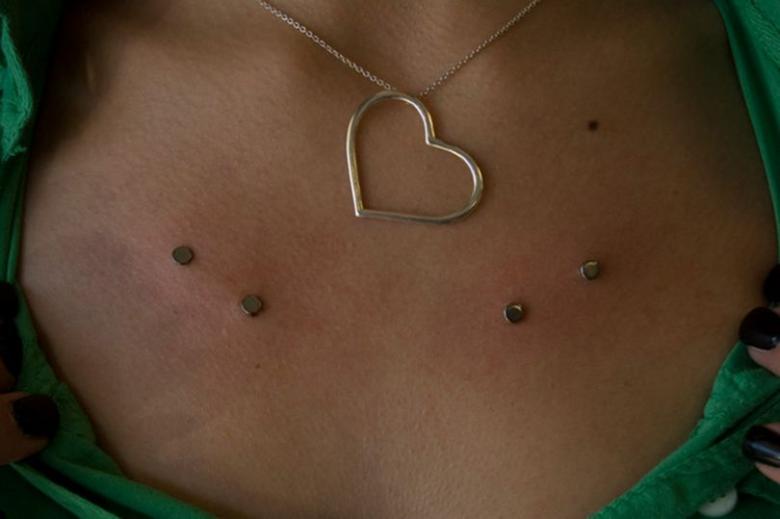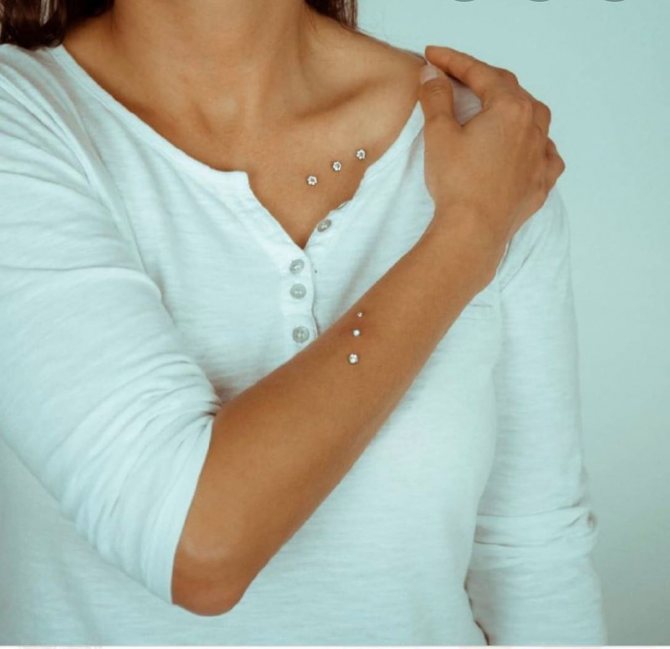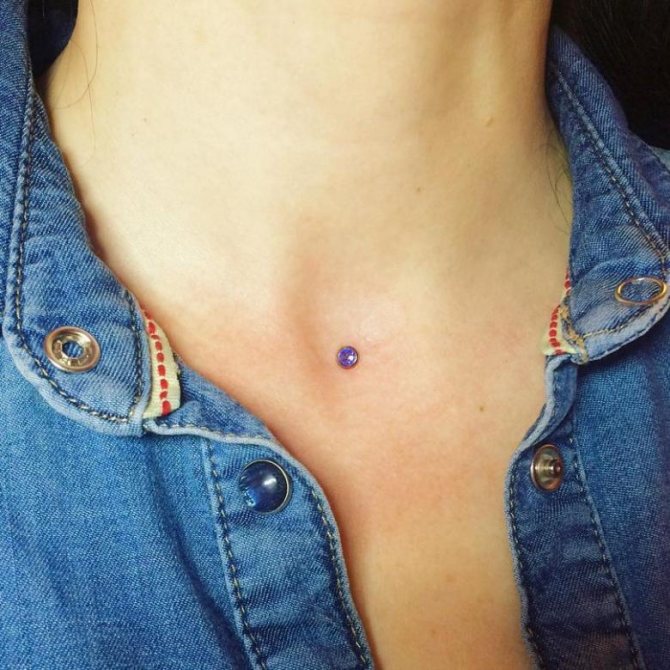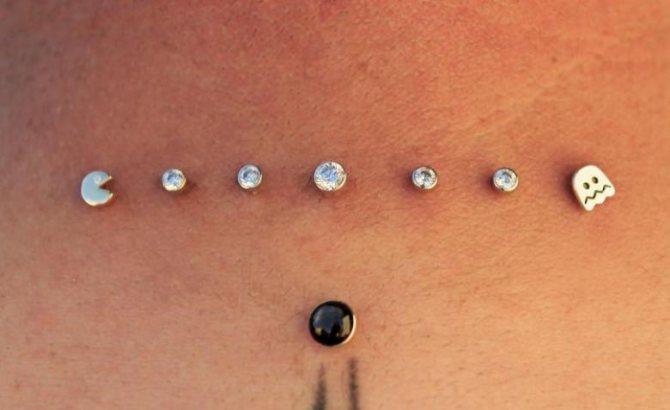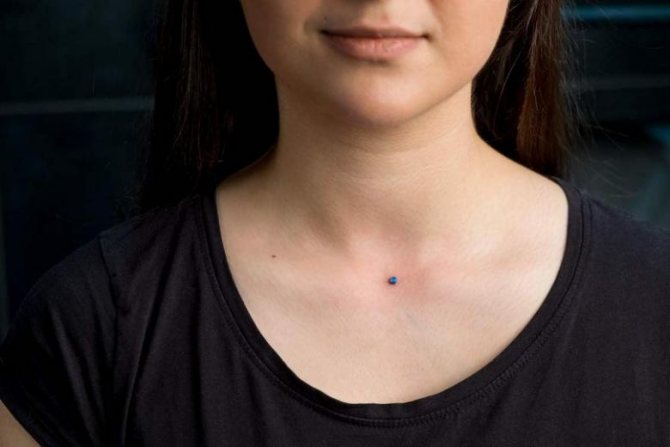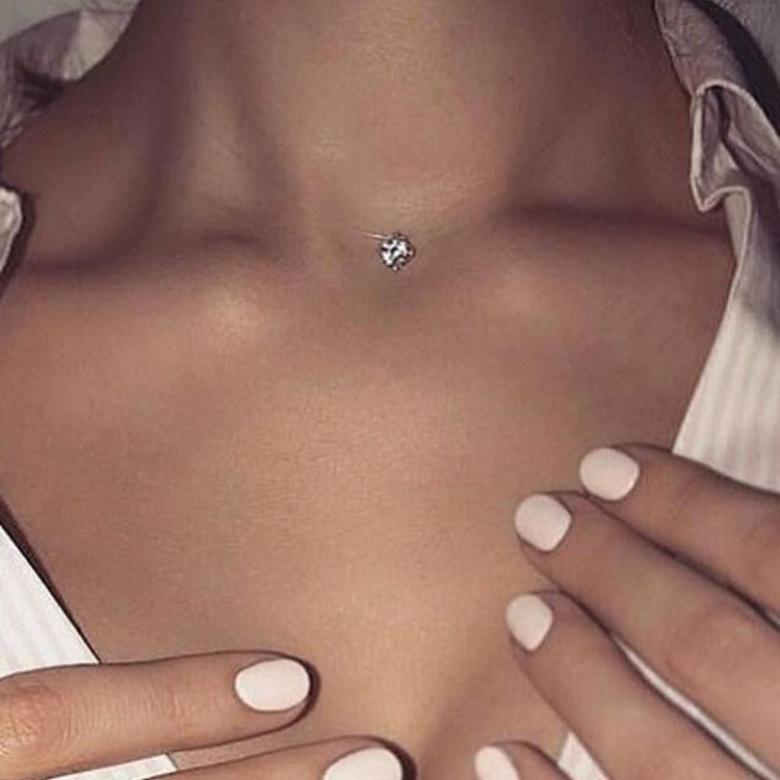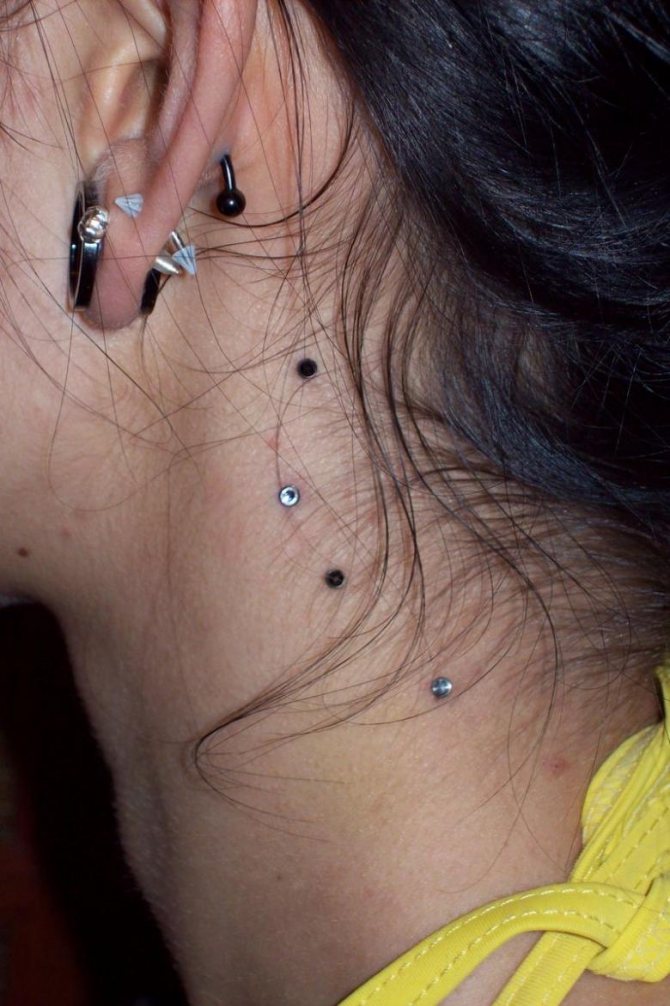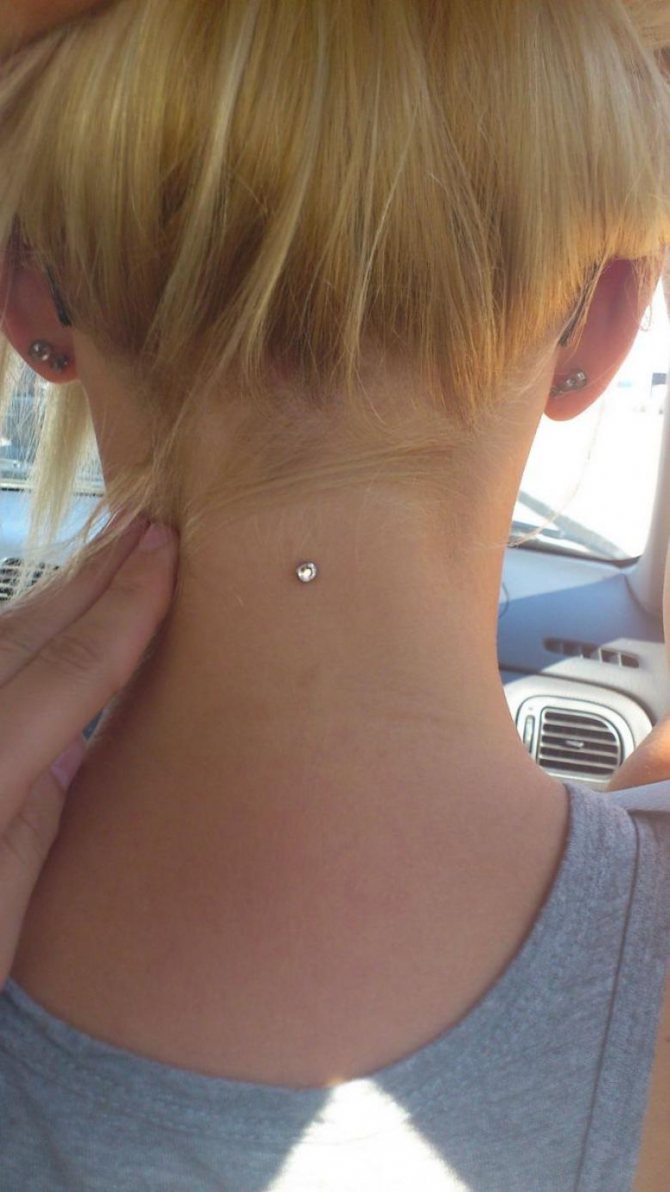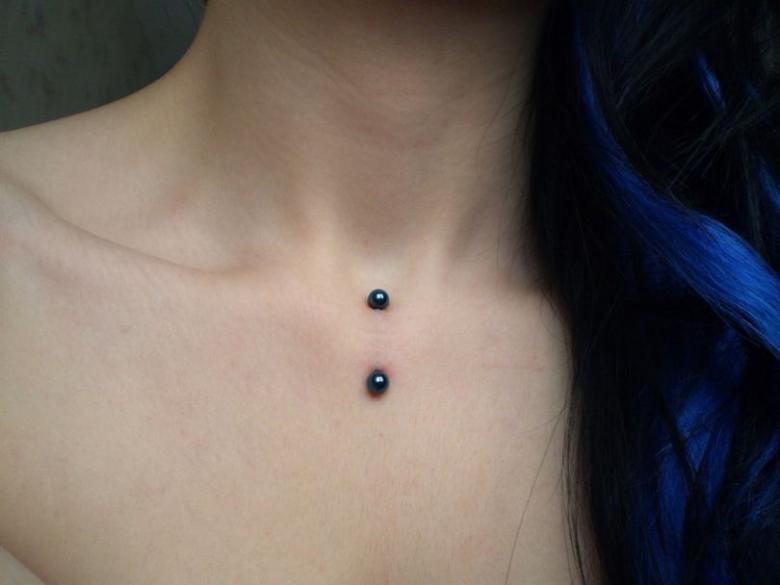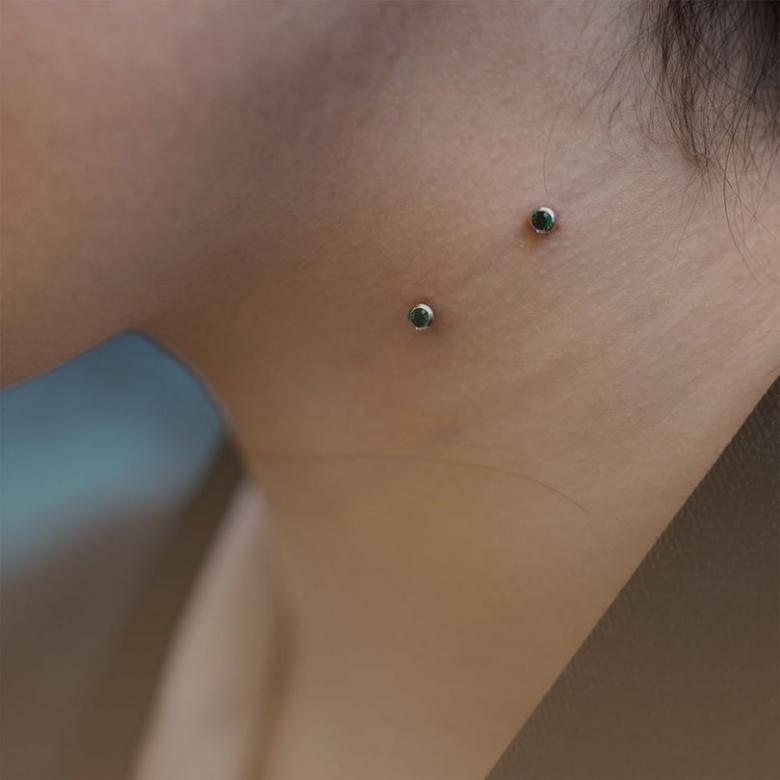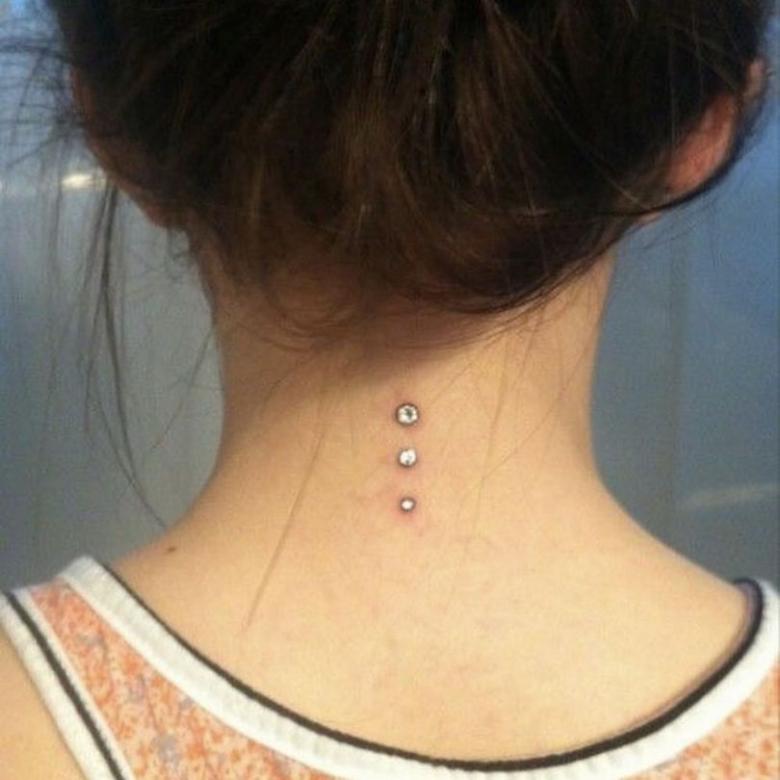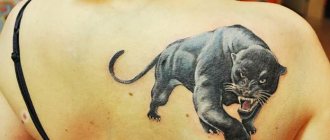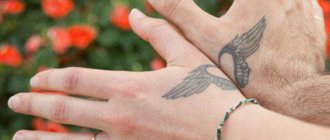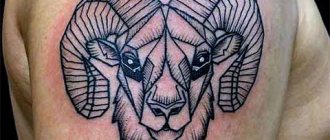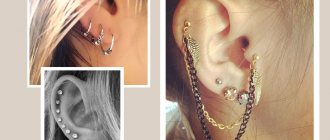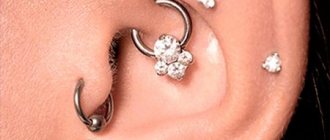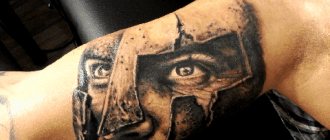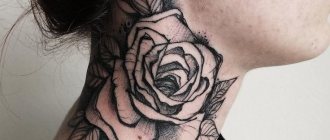The need to decorate and modify the body is peculiar to people of all eras and cultures. One of the popular ways to improve your appearance is piercing, when in different parts of the body are made punctures and incisions to insert earrings, rings, tunnels. Modern types of body modification include not only ear or belly button piercings. Thanks to the advent of flat subcutaneous jewelry, people now have the opportunity to decorate their bodies almost anywhere. A popular method of piercing using this type of implant is microdermals on the clavicles.
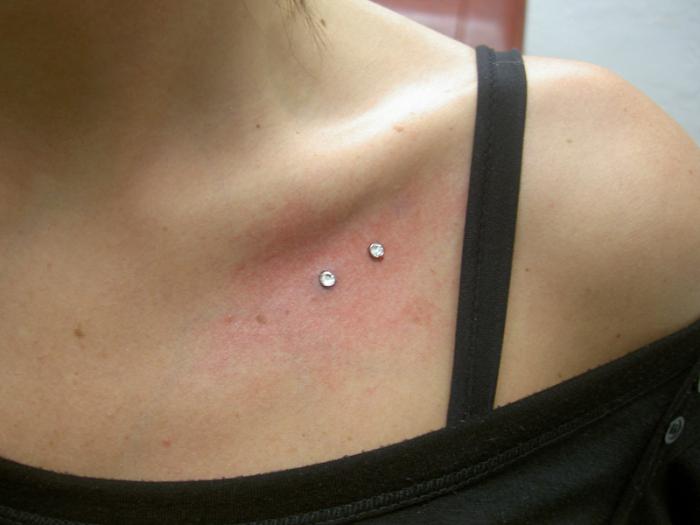
Microdermals - what they are and their cost
Microdermal on the neck (photo demonstrates the decoration visually), face, arm, chest, collarbone, lower back is an ornament that is implanted inside the skin. It is an intradermal micro implantation.
The essence of the process is as follows:
- A hole is made in the skin with a large-diameter "Punch" needle. At the puncture point, the living, rapidly dividing growth layer of the skin is incised into a pocket of 1.5 mm.
- A thin titanium anchor (plate with holes) is inserted into this small puncture or incision.
- Through these holes, the skin tissue subsequently sprouts.


Titanium alloy (medical steel) is used for the production of products. Dental rods, dentures, pins of all kinds - titanium implant elements.
Titanium has unique characteristics:
- the refractory, dense, lightweight metal is best suited for body jewelry;
- the metal does not tend to cause allergic reactions;
- There is no antagonism with the lymph;
- cases of rejection are extremely rare.
There is a significant difference between dermal and ordinary piercing. In the first decoration, you can see the decorated part of it, and the piercing also shows the rod for fixing the parts.
The price of the jewelry is in dynamics. During 2021 there is a decrease in price from 2650 rubles at the beginning of the year to 2520 rubles by the end of the half-year, there are no price changes for July.
Types of piercings
FACIAL PIERCING
Eyebrow piercing
This is a type of facial piercing where a piercing is made in the eyebrow area for the purpose of installing and wearing an ornament. Wearing this type of piercing is equally common among both genders. There are different locations of eyebrow piercings as well as different varieties of jewelry. Healing of the piercing takes on average 6-8 weeks. Eyebrow piercing refers to planar types of piercings due to what there is a chance of rejection, which can be minimized with careful care of the piercing during the healing period.
Eyebrow piercing options: Vertical piercing: when the eyebrow is pierced vertically, the decoration protrudes more from the skin than when pierced at an angle and is more likely to cling to clothing and hair, so this type of eyebrow piercing is less common.
Decorations: banana, bar bent under flat piercings, ring with a ball-end closure, segmented ring, special eyebrow jewelry.
Piercing at an angle to the eye: the piercing can be done at different angles, depending on the wishes and individual features of the anatomy of the client and the preferences of the piercing master.
Decorations: a banana, a bar bent under the flat piercing, a ring with a ball-clasp, a segmental ring, special decorations for the eyebrow.
Horizontal piercing: the piercing is made parallel under or over the main ridge of the eyebrow, depending on the piercing master's preference. This type of piercing is considered more complex than angle piercing and vertical piercing.
Embellishments: banana, barbell bent under flat piercings.
Anti-eyebrow: a type of flat piercing in which the piercing is made at the top of the cheek, under the eye. The decoration is usually placed at an angle so that the lower ball is closer to the ear than the upper one.
Decorations: a banana, a rod bent under the flat piercing.
Piercing the forehead Third eye - a piercing is made on the forehead, in the middle, just above the eyebrows.
Decorations: microdermal.
Eye Piercing
A very rare type of piercing, usually made in the corner of the eyelid.
Accessories: micro banana, ring with a balloon clasp, micro circular.
Nose Piercing
A type of facial piercing in which a piercing is made in the nose to wear jewelry. There are different options for nose piercings with different types of jewelry.
Types of nose piercings: Bridge: Piercing the tissue at the bridge of the nose, at eye level, or between the eyebrows. There are horizontal and vertical piercing options.
Embellishments: barbell, bent barbell under flat punctures.
Tip of nose piercing: Piercing the top of the nostril from the inside to the tip of the nose.
Decorations: rod.
Austin Bar: Horizontal piercing of the tip of the nose. Named after the first owner of this type of piercing. Only the tissues of the nasal tip are punctured, the cartilaginous septum (septum) is not affected.
Embellishments: a barbell.
Nostril piercing: A single piercing or a combination of piercings of one or both nostrils is possible.
Ornaments: rings with ball clasp, segment rings, nostrils, sometimes labrets, special straight nostril "bones" for nostril piercings.
Septum: A piercing of the central nasal septum between the nostrils with the installation of jewelry so that it was visible from the nostrils, above the upper lip.
Decorations: septum clickers, ball-ring, circulars(horseshoes), sometimes micro bananas or barbells.
Septril: The puncture of the underside of the tip of the nose. The puncture is made centrally through an extended septum puncture towards the lower flat protrusion of the nose.
Embellishments: barbell.
Nasallang: A combination of piercings of both nostrils and a piercing of the septum (septum) united by a common decoration, usually a barbell.
Cheek Piercing
A type of facial piercing in which the piercing is made in the cheek. The most popular variant of cheek piercing is when a piercing is made through facial tissue into the oral cavity. It is common to place two ornaments, symmetrically on both cheeks, so that the piercing creates or imitates dimples on the cheeks.
Ornaments: labrettes with a diameter of 1.6 mm with one flat side and a decoration - a ball.
Mouth piercing
The creation of a piercing in the mouth region, for the purpose of wearing a jewelry.
Options for piercing: Tunnel in the lip (lip plate): a superficial piercing of the lip. The modification is obtained by stretching the lip piercing. The lips can be stretched almost indefinitely, as the lips are very different from the tissues of other parts of the body capable of such stretching. The diameter of the holes in the lips, and consequently the size of the lips can reach 400 mm or more. At the same time, the sensitivity of the lips is still preserved throughout its entire surface, even at enormous size.
Decorations: tunnels, plugs.
Frenulum piercing: a form of oral piercing in which the frenulum of the upper or lower lip is pierced. The upper lip frenulum piercing is also sometimes called a "smiley face" because the piercing can be seen when the wearer is smiling. The lower lip frenulum piercing, on the other hand, is sometimes associated with a frown and is called an "anti-smile." This type of piercing is easy to install and takes six to nine weeks to take root. To the outside view, the piercing is only noticeable when large jewelry is worn.
Ornaments: Ring with ball clasp, segment ring, circular (horseshoe), barbell or small diameter banana.
Monroe/Madonna: the piercing is done off-center above the upper lip and mimics a mole. The Monroe piercing is also called "Madonna" and "Crawford" after the famous women who had a mole in the mouth area - Marilyn Monroe, Madonna and Cindy Crawford. An additional variation of this type of piercing is the paired Monroe piercing, in which two symmetrical piercings are created on different sides above the upper lip.
The Monroe piercing became widespread in the 90's thanks to Reina, the bassist of the band Coal Chamber, also pierced by Ashley Massaro, Matia Buena. This type of piercing is more common among women, however, has a certain popularity among men, of famous men it is worn by Cyrus Trace.
The average healing time of the piercing, when it is made by a professional piercer, is from 8 to 12 weeks, in some cases healing occurs in 3-6 weeks.In comparison with other types of piercing, the Monroe piercing is relatively painless due to the thinness of the tissue and the small number of nerves located in this area of the body. There is a small risk of snagging the upper lip artery located just above the upper lip.
Ornamentation: labret.
Labret: literally meaning "lip decoration", the puncture is made through the lower lip below the level of the teeth.
Ornaments: labret.
A vertical labret (Estrum) is a vertical piercing of the lip. The most aesthetically pleasing is the piercing, made perpendicular to the lip, when the needle enters the border of the lower lip from below and exits through the center from above. Micro bananas of different sizes are suitable for this piercing, depending on the thickness of the lips.
Decorations: micro banana.
A horizontal labret is a horizontal puncture of the lip. Here everything is much more complicated: the puncture is parallel to the lip and if the needle is not deep enough, the jewelry can be rejected. In addition, it takes much longer for such a piercing to heal than a vertical labret or Medusa. The piercing is constantly out in the open, and besides, not licking the lips is quite difficult. And when you lick your lips, saliva, along with bacteria, is very good at penetrating the piercing.
Decorations: micro banana.
Ashley piercing is similar to a reverse vertical labret, one end of the decoration is on top of the lower lip and the other end is inside the mouth. The piercing looks unique because only the part of the ornament that is in the middle of the lower lip is visible.
Ornaments: micro banana.
Lowbret - just like a labret is done in the lower part of the lip, but is located much lower than a regular labret.
Decoration: labret.
Vertical Lowbret - the puncture is made in the oral cavity between the lower lip and the teeth and comes out from below the edge of the lower jaw. Healing is usually without complications, although the puncture can seem quite painful at first glance.
Ornaments: the bar, the length depends on the anatomy of the particular person.
Chin piercing - the decoration passes through the surface of the flesh of the chin. Sometimes done horizontally, the vertical location is the most common and heals faster. In fact, it is one of the varieties of Lowbret piercing.
Embellishments: a barbell, a barbell bent under flat punctures.
Jellyfish: the name was coined in 1990 by Kerrick, a hairdresser and model from Toronto, Canada. The Medusa is a variation of the labret in which the piercing is done in the middle of the lip groove, under the septum of the nose. One of the variations of the Medusa piercing is the Estrum (vertical labret). The jellyfish heals within 3-4 weeks.
Ornamentation: labret.
Jestrum: is a vertical piercing through the upper lip. It is similar to a vertical labret, but through the upper lip instead of the lower lip. It was first made by Jesika Bornsen, (hence the name), by piercing master Derek Lowe.
Jewelry: labret.
In addition to the basic types, there are combinations of piercings that have their own names:


Angel bite - symmetrically placed two monroe punctures; Dog bite - performed by punctures in the upper lip and lower lip, and in parallel; Cyber bite - symmetrically placed top and bottom labret and jellyfish punctures; Dahlia bite - performed by two punctures in the corners of the lips; A dolphin bite - two symmetrically placed punctures labret with decorations, like the singer of the band Disturbed; Snake bite - punctures in the lower lip on both sides symmetrically; Spider bite - made by punctures on one side in two places in a row; Shark bite - made a puncture in the lower lip in four places, two on each side;
Tongue Piercing
Represents one of the most common types of piercings in modern Western culture, after ear piercings.
Variants of piercings: Vertical tongue piercing - done with a special needle. The piercing of the tongue is not very painful, because the tongue is a muscle consisting of longitudinal fibers, and the needle passes between them. However, after the puncture, the tongue can swell and become sensitive, which is often very uncomfortable. Sometimes several punctures are made at once, along the center of the tongue. Healing time - It takes about 4 to 6 weeks to heal completely. The first 3 to 4 days due to swelling of the tongue will be difficult to speak and 2 to 3 weeks it will be difficult to eat.
Decorations: barbell.
Horizontal tongue piercing - looks exactly as it sounds. The piercing is done through the tongue (from ear to ear), not vertically.
Embellishments: a rod.
Tongue surface piercing - the tongue is pierced not through, but along or across. Such punctures of the tongue are possible (although they are prone to rejection and displacement of the decoration). Special care should be taken to make sure that the ornament does not interfere with the movement of the tongue. There are varieties of this type of piercing: Lingum Piercing - the term was coined by John Cobb in 1993, a piercing on the lower surface of the tongue. This placement is less prone to rejection than others. Scoop Piercing - the name for a horizontally placed piercing of the surface of the tongue.
Embellishments: bar, bar bent under flat piercings, ball-and-socket rings, segmental rings.
Tongue tip piercing - sometimes the tip of the tongue is pierced. This type of piercing can cause serious damage to the teeth. Care must be taken in the choice of placement and jewelry.
Decorations: spiral, circular (horseshoe), ring with a balloon clasp, segmental ring.
Tongue frenulum piercing (frenulum) - The piercing is done through the frenulum tissue located under the tongue to wear the jewelry in it. The piercing procedure is quite simple and quick, however, in some cases, the piercing will eventually come off. For some people, this type of piercing is impossible due to the peculiarities of the anatomy.
Decorations: banana, circular (horseshoe).
Piercing of the uvula
The piercing is made on the uvula (the small pear-shaped appendix at the beginning of the throat).
Decorations: ring with a ball clasp, segment ring, circular (horseshoe).
Ear piercing
The creation of a piercing in a part of the outer ear for the purpose of inserting and wearing an ornament.
Ear piercing options: Earlobe piercing - the lobe is the soft fleshy lower part of the ear and consists of connective fatty tissue covered by skin. Almost painless procedure.
Jewelry: earrings, ring with a ball clasp, segment ring, barbell, banana, circular (horseshoe), etc.
Helix piercing: A piercing in the helix of the ear or in the upper part of the ear (cartilage). Generally, the piercing is done with a hollow, small-sized piercing needle
Ornaments: rings with ball clasp, segmental rings, circumcircles (horseshoes), labrets.
Snug piercing is a puncture of the lower cartilage, slightly above the antitragus (also called anthelix).
Ornaments: rings with ball clasp, segmental rings, circumcirculars(horseshoes), labrelets.
Forward helix piercing - piercing the curl of the ear at a distance close to the head.
Decorations: ring with a ball clasp, segmental ring, labret, circular(subclave).
Daith - the piercing is located inside the auricle passes through the middle cartilage. Daith piercing was created in 1992 by Eric Dakota and his client. Eric Dakota's client, who studied Hebrew in college, was the first to call this piercing ("Daith" meaning "knowledge"). Her reasoning was that the piercer had to be very smart to do the piercing. The woman sincerely believed in a doctrine of piercing that has existed in India for about 3,000 years: rings are inserted into holes in the body as "gatekeepers". They can be, magically, charged at the moment of the piercing, to act as a "filter" of what can pass through those holes. In the case of the ear, appropriately placed and charged rings can filter out the nonsense the interlocutor is saying and let the intelligent thoughts pass through. Eric and the client, in creating this piercing, were guided by this very teaching and the woman gave it a name in Hebrew: Daith. A true Daith must be made so that the lower part of the ring comes straight out of the ear canal and is not visible behind the tragus. If the inlet and outlet of the ring are visible, the piercing is not a true Daith. The technique of this piercing is very progressive and requires a specially curved needle, it was developed by Eric Dakote.
Decorations: ring with ball clasp, segment ring, micro banana, micro circular (horseshoe), septum clicker.
Industrial: piercing any two holes connected by one straight ornament, but more often two upper cartilage punctures. One is made fairly close to the head, the second down the cartilage, on the opposite side of the ear.
Embellishments: an industrial barbell.
Socket piercing or tragus piercing (from Tragus piercing): the piercing of the part of the outer ear that is directly opposite the auricle. The piercing is done with great care to avoid touching the tissues deeper than the ovary.
Decorations: rod, labret, small ring with a ball clasp, segmental ring, circular.
Anticocele piercing: made by piercing a hole in the inner part of the ear cartilage. The puncture is made in the very contra ossicle, the part of the cartilage opposite the ear canal. This type of puncture bears a direct resemblance to the puncture of the goatee (tragus), these punctures are done almost identically and require extremely similar care. By analogy with the English name, the antigoele piercing is also called the antitragus piercing.
Embellishments: a small ring with a ball clasp, a segmental ring, a labret.
Rook - inner ear cartilage puncture, located at the top of the auricle about 12-25 mm from the top of the ear.
Decorations: ring with a ball clasp, segmental ring, banana, rod.
Conch - located inside the auricle, slightly above the lobe. When choosing this location for this piercing, it is important to consider where and how the jewelry will be placed in the back of the ear. If they are not placed correctly, it can cause discomfort, especially during sleep.
Decorations: a ring with a ball clasp, a labret, a tunnel or a small diameter plug.
Tunnels: the earlobe is pierced with a needle, a labret or a ring is inserted until the puncture is completely healed. The canal is then stretched with tapers, after which a tunnel or plug is inserted. Particularly large diameters can be cut with a scalpel. A tunnel up to 8-10 mm in diameter is most often tightened after removal, if larger, surgical intervention may be necessary, although the particularities of each person's body play a large role in this. If the diameter of the hole is too large, the inner wall of the hole is trimmed to close, and then it closes rather quickly. If the hole is too large, it is simply closed.
Decorations: extensions, tunnels, plugs, fangs and claws.
Advantages as body decorations
Microdermal on any part of the body has differences compared to piercings:
- It is placed on the skin in the area of mobility, on deformed, stretched areas;
- the threat of marks, formations in the form of scars is unlikely;
- the design does not pose a risk of accidentally picking it up with clothing parts;
- the implantation sites heal quickly;
- there is a chance to change anchor attachments if desired;
- installation is safe on hypersensitive areas, intimate areas.

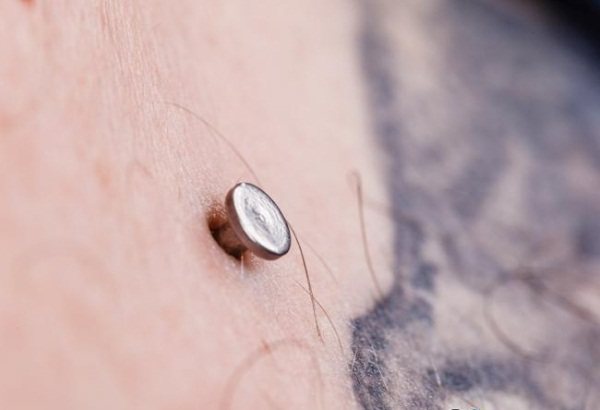
Initially, you should use nozzles in the form of flat discs, because it is more difficult to accidentally hit them, because they are close to the skin.
How to choose a decoration
Clavicle piercing implies the choice of jewelry according to two components: the appearance and the metal.
The first one is determined by personal tastes, the second directly affects the healing process of the piercing.
The safest choice is surgical titanium: when it is used, the risk that a flat piercing will become inflamed is minimized.
Surgical steel, niobium and gold are also used, but the risk of unpleasant consequences increases significantly.
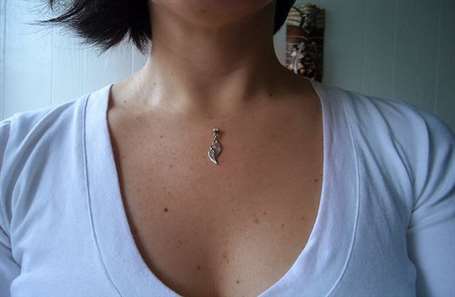

It is important to make sure that the earring fully touches the skin and does not protrude too much.
Types of microdermal hairpins
A variety of twists have been developed for the benefit of women. The most popular is the titanium opal twist.


Masters recommend:
- flat figures in the form of disks, nails and cones, crosses and hearts;
- A separate group of twists with precious or semi-precious stones;
- There is a distinction between the twists for everyday use and those that look better in a festive atmosphere;
- Large, convex, shaped curls are not suitable for everyday wear.
Using micro-implants, there is a temptation to show affluence. Gold or diamond in a gilded setting is a demonstration of narcissism and exclusivity.
Anchors for implants are in a constant state of improvement. Modern products are characterized by larger holes and a minimal amount of framing metal. Practice has shown that such anchors facilitate the tissue healing process.
On the neck
Neck jewelry in a single or group decoration represents a certain mark, since a woman's neck is a gracefully refined place, waiting for a refined and elegant decoration. An important nuance in piercing is the skill of the master - the installation of the plate from the first try.
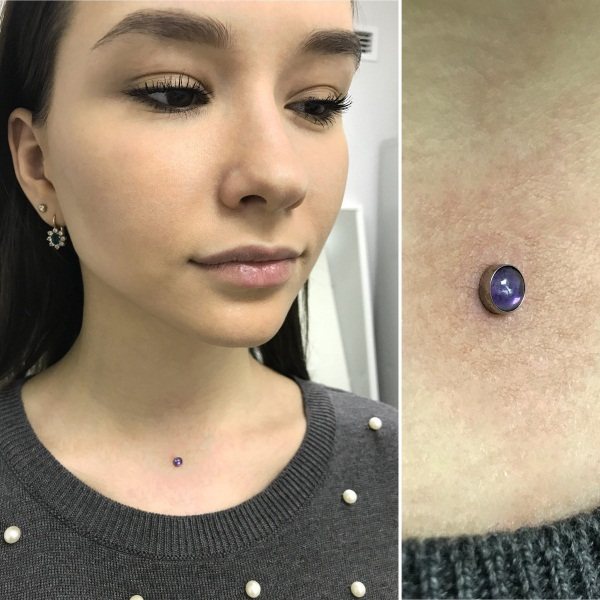

There are some peculiarities of work on the neck:
- The plate is inserted under the skin usually below the back of the neck.
- Group decorations in the form of two interesting tracks adorn a woman's neck on both sides.
- Girls with short haircuts prefer to install anchors with curls just below the hairline.
- Several implants on the same area of the skin are inserted at a distance of 7-8 mm.
- At the end of the procedure, a decorative detail is screwed onto the rod.
- The resulting design is fixed, which is very important in the first days of installation.
- The work site is taped over with a bacterial patch to prevent the irritant from penetrating the unhealed wound.
- It is recommended to exclude loose clothing for a while in order not to traumatize the healing dermal wound on any part of the body.

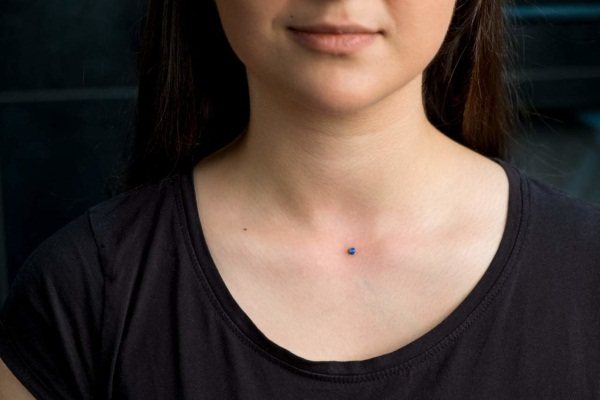
For the skin to quickly recover, you need to choose the place of implantation of the jewelry: inaccessible to contact with clothing and other parts of the body. Beautifully looks a combination of dermal in the composition with a tattoo.
Conclusion
Decorations for flat piercings, which are installed in the area of the collarbone cavities, are called microdermals. These are flat metal implants that are implanted under the skin through a small surgical incision. A small pin is left on the surface, to which the decorative element is screwed. The installation procedure requires the involvement of a qualified dermatologist or surgeon, as well as sterile conditions. The wound must be carefully cared for to avoid infection.


On the collarbones.
Those who wish to choose the least painful procedure should keep in mind that the process of placing the dermal differs from place to place on the human body. Since the skin is not equally sensitive everywhere, the procedure may be accompanied by more or less unpleasant sensations of pain.
The twisted rod located in the subclavian area, in the décolletage area imitates a pendant, looks seductive. On light-skinned girls look nice dark jewelry, on beauties with swarthy skin it is more effective to install light-colored products.
Installation on the collarbone has the following advantages:
- The accretion site is accessible for handling;
- minimal possibility of snagging the device with clothing.
- Below the collarbones, a cabachon track looks good.
During the period of biointegration (ingrowth), you should not move, take out or scroll the device.
What are microdermal implants?
They are small, flat-shaped metal implants that are implanted into the skin. For this purpose, the upper thin superficial layer of the epidermis is incised with a thin scalpel, and then a metal plate is inserted into the incision. It is inserted so that the outer (decorative) part with the pin remains outside. The decorative element - a stone or crystal - is attached to it.
Microdermal is a universal piece of jewelry. Theoretically, there are no restrictions on areas: the implant can be placed on the face, arms, torso, hands, legs. Traditionally, this type of piercing can be seen
- In the decollete area (in the cleavage between the breasts in girls);
- On the back of the neck;
- On the abdomen in the area of the iliac bone.


It is most often used in the area of the subclavian cavities. Microdermals are also often placed between the clavicles - in the depression at the base of the neck. In this area they look very beautiful and seductive, on slender and thin girls with milky-white skin will look interesting dark jewelry, on the swarthy beauties it is more effective to put a light-colored jewelry.
On the face
The face is the most popular area for jewelry. The most popular places for their introduction: the cheeks, the frontal part, cheekbones. In the photos of professional piercings, you can see that microdermals look like moles.
The procedure is performed traditionally:
- The top layer of skin is pierced, incised, and the plate is inserted;
- After insertion, the dermal is fixed tightly with a plaster for 2 days;
- the puncture site must be dry, it is important to avoid irritation;
- Treatment is carried out only with disinfectants, which include Octenisept, Dioxidin;

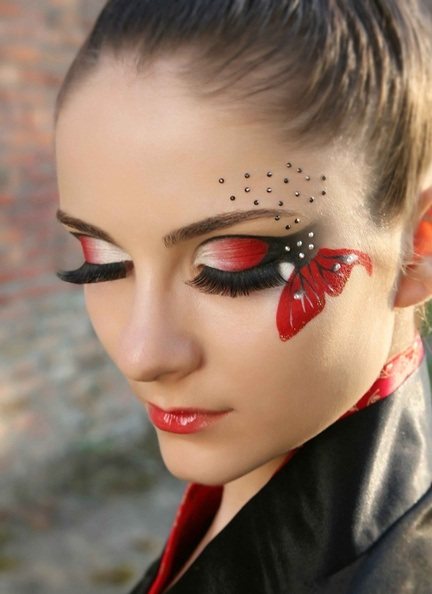
In this area, it is preferable to use miniature and flat for convenience during sleep. The delicate skin of the face can be damaged by a small trauma and an inflammatory process can start from a minor contamination. And as the most extreme condition - the body rejects the innovation and the appearance of white marks on the face.
The use of cosmetics should be very moderate and careful not to provoke unwanted consequences.
How to attach an earring between the collarbones
Microdermal piercing - the procedure is easy and fast. The entire process takes no more than 10 minutes. When the client comes to the salon, he and the beautician agree on the location of the piercing. In our case it is the skin between the clavicles. Then the master wears gloves and treats the instruments. Then antiseptic goes over the place of the future piercing, and when the skin dries, mark with a marker.
The incision is made with a special tool, the panch. It looks like a round scalpel. Penetration under the skin is minimal - only 1-2 millimeters. Here, by the way, lies the name of the piercing "microdermal". It is so called because it is the dermal layer of the skin that can be traumatized. A small pocket is cut through with it, where the base of the jewelry is inserted. It is usually called an anchor.
—>
After that, the master will put a plaster on the pierced spot and give recommendations. They concern the care of the wound and the change of jewelry. Rehabilitation usually does not take long. The main thing is to avoid infection and the development of inflammation in the piercing.
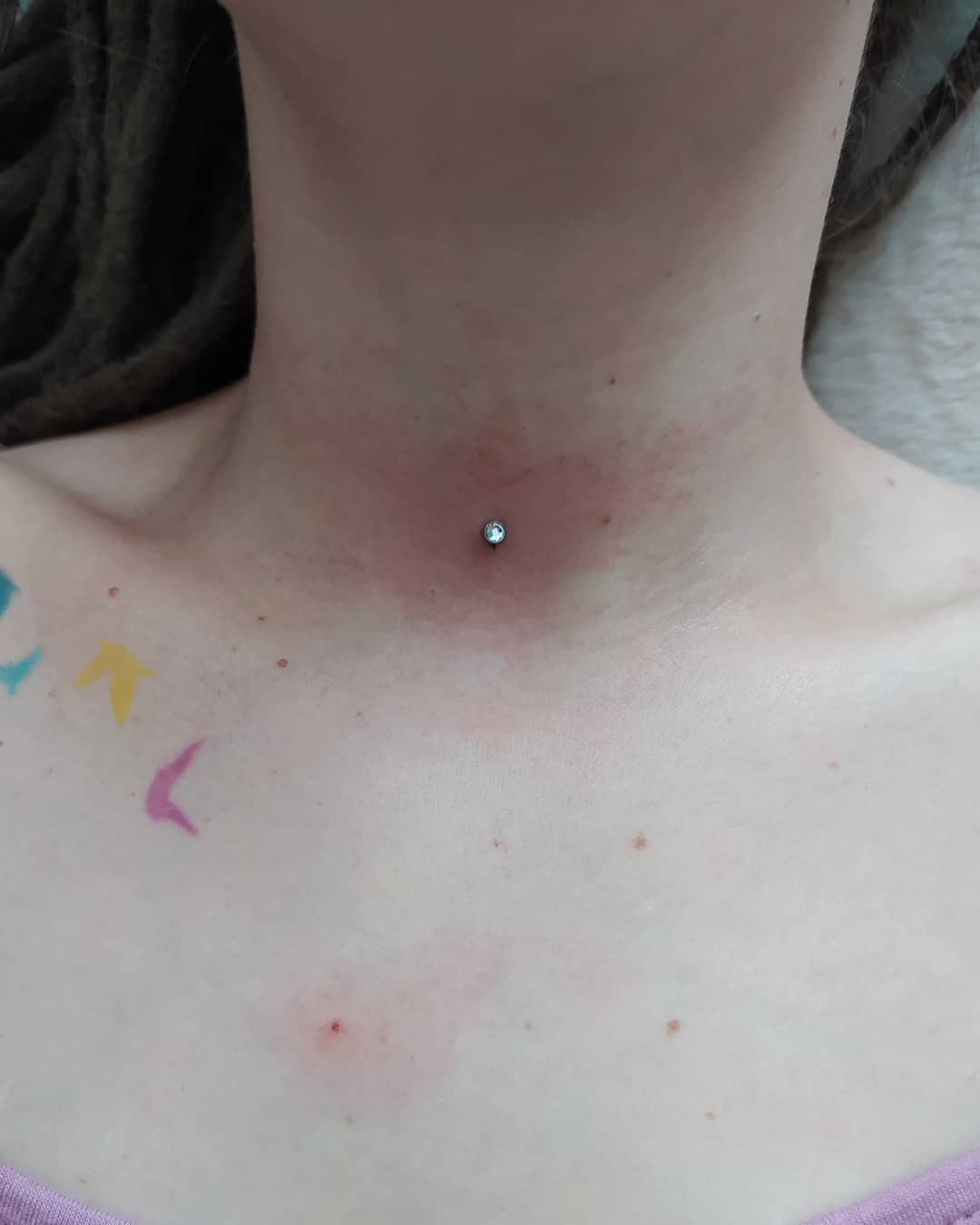

@piercing_stav
On hand
Microdermal piercings on the neck (photo shows the nuances of piercing), as well as on the arm cannot fail to attract the attention of others. The hand appears to be a multifunctional limb, so the choice of place of implantation is of particular importance. The process of installing the jewelry is similar to the other place on the body.
The work is done in stages:
- Pre-cleaning and treatment of the skin of the hand with antiseptic.
- A small technological incision (3 mm) is made.
- An anchor is placed in the hole so that the pin is on the outside.
- On it, a jewel of the hostess' choice is screwed on (a flat one is recommended).
- The incision should be treated with antiseptic and covered with plaster.
Jewelry is preferably implanted on the outside of the hand. Large and convex shapes are desirable not to screw on for reasons of possible injury.
Microdermal placement: possible complications and problems
We have already figured out how microdermals are made. Installing them is also not as difficult as it seems at first glance. This modification is very comfortable, it does not restrict movement and does not leave large scars. Although, it must be said that there may be minor complications. As a rule, they occur in the case of microdermal installation at home.
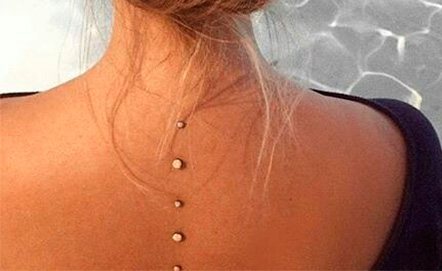

Microdermals on the back
In addition, the area with the puncture is inflamed and scars form when the microdermal is untimely "pulled out" and twisted. The skin is traumatized from the inside with every such movement, and scar tissue begins to grow. So, the more there is microtrauma in the puncture area, the more scar tissue will build up and eventually, the microdermal may come out at all.
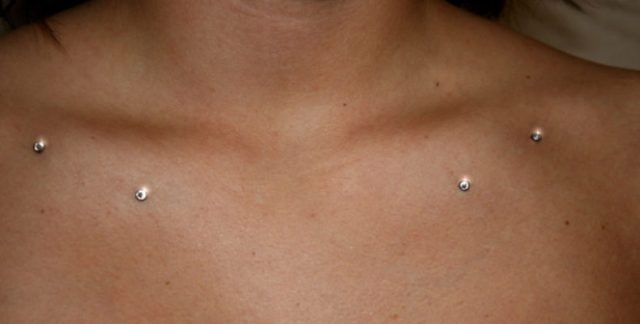

Microdermals on the collarbones
It is best to have the jewelry removed by the master who placed it. Trust your body only to professionals!
Author: Katerina Sergeenko
On the finger
In addition to microdermal on the face, neck or hands, which is among the extravagant jewelry, installation on the finger is allowed, although this place is not considered the most suitable place for implants. If the customer wishes, the master can imitate a ring on the finger. Fingers of various sizes and configurations help in this event.
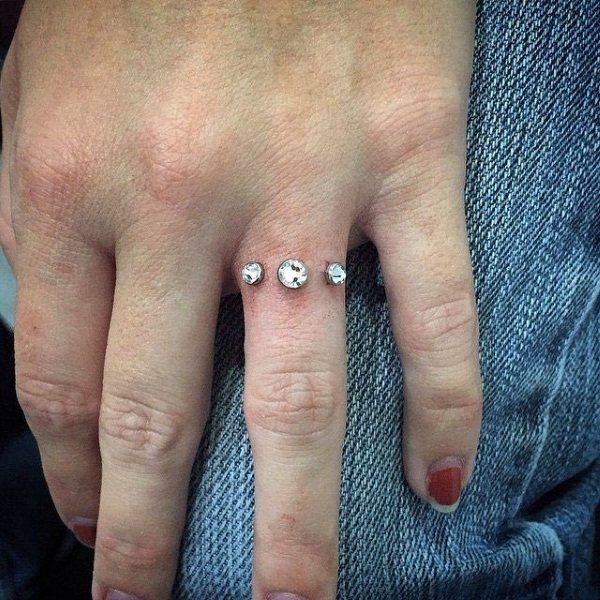

The technique of placing a microdermal on the finger is as simple as on the hand or neck, for example.
But there are distinctive features in the planning:
- Initially, the client's occupation should be kept in mind;
- the wearing of the jewelry should be treated with a high degree of care;
- There are increased requirements for the care elements of the jewelry.
All precautions are limited to avoiding inflammation. Before deciding to pierce in this place, it is necessary to carefully analyze all possible dangers.
Possible complications after flat piercing
Like any type of minimally invasive intervention, the installation of microdermals between the clavicles can lead to negative consequences:
- infection;
- Scar tissue formation;
- Rejection of the implant.
Infection is the most common side effect of microdermal placement. It can be a consequence of non-compliance with the rules of care, as well as reduced immunity. Signs of an infection of the wound are as follows:
- Reddening of the area in the area of the incision;
- exudate secretion and pus formation;
- Increasing soreness;
- an increase in body temperature;
- symptoms of intoxication - headache, weakness.
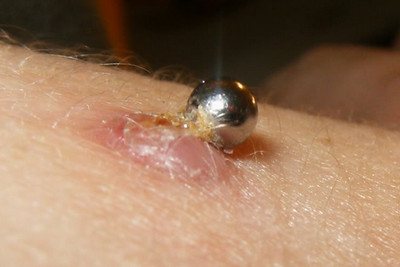

In this case you should see a dermatologist or surgeon who will examine the wound and take measures to drain the wound to drain the pus. The implant may have to be removed.
Microdermal rejection is rare. It is usually due to the individual characteristics of the body, as well as the improper selection of the material. Signs of rejection are similar to the symptoms of infection, which can be superimposed signs of an allergic reaction - redness, rash, itching at the implant site.
On the abdomen
Unlike piercings on the open areas of the body, it is not safe to implant an implant on the abdomen. The work is complicated by the presence of a layer of fat.
Only an experienced specialist can perform an implant in this area:
- A hole is made to a depth of up to 5 mm;
- the plate is inserted;
- A piece of jewelry is screwed on as you prefer.

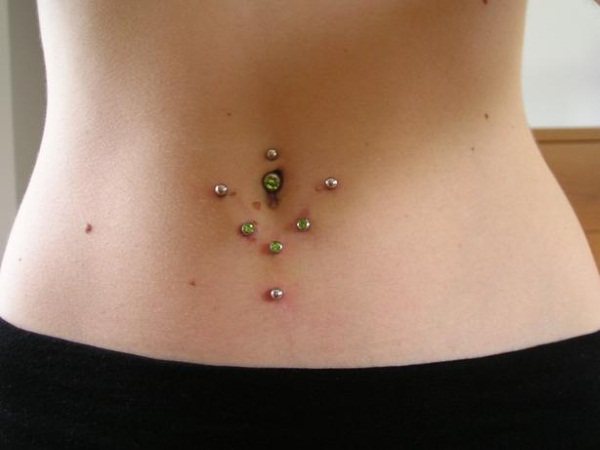
Under the influence of elevated temperature under the clothes on the wound, you can get a diaper rash. In addition, clothing can cause trauma to a fresh wound. The originality and sexiness of the dermal must be maintained by careful care. The puncture site must be carefully guarded so that it does not become a problem.
Possible negative consequences
If care is not taken in good faith, some complications are possible (as with any other type of piercing). If the jewelry is of low-quality metal, it will entail rejection with an inflammatory process.
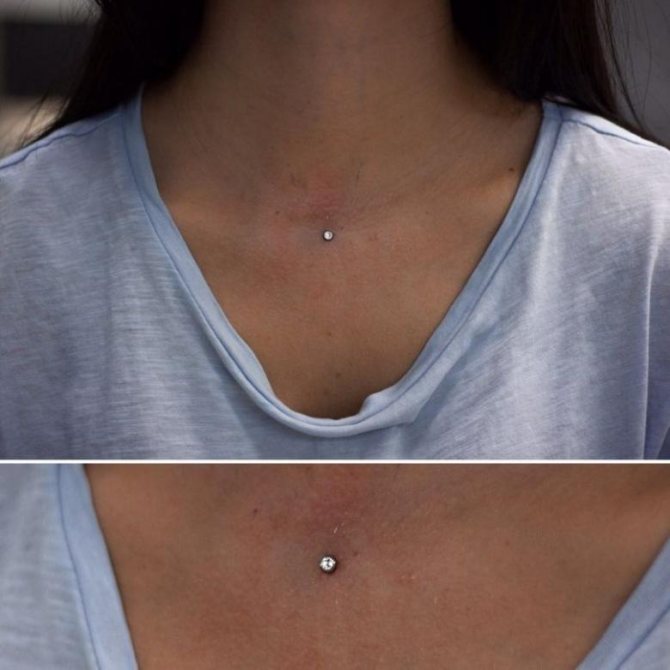

If the sanitary conditions are not met, it is possible to get an infection, festering. You should not remove the microdermal yourself - you can leave a deep wound that will grow into a not very pretty scar. To get rid of the microdermal, it is better to consult a master.
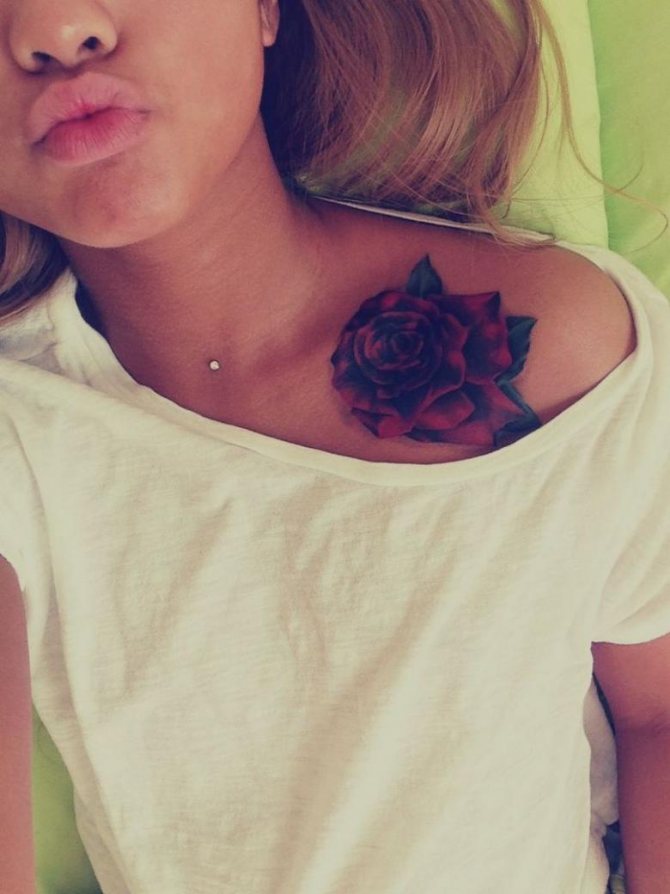

Neck piercing is original, sexy and insanely beautiful. With the right choice of jewelry you can create a delightful image. But before you do it - think about whether you can comply with all the necessary conditions in the healing process.
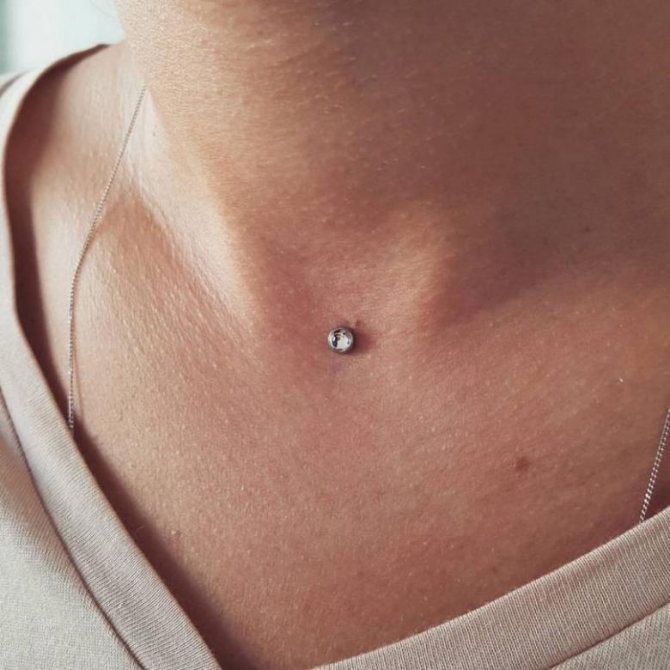

Find a good master in a studio with positive reviews (by no means do it yourself), think about how to comply with all the norms in advance and go ahead. After all the procedures, such body modification will please you for a long time and complement your beauty.
In the decollete area
Microdermal in the decollete area, as the most popular area for implants, looks spectacular. Along the central part of the decollete above the breasts, as well as on the neck, it is practiced to implant plates with balloons, discs. In the photos you can see several options for the placement of jewelry.
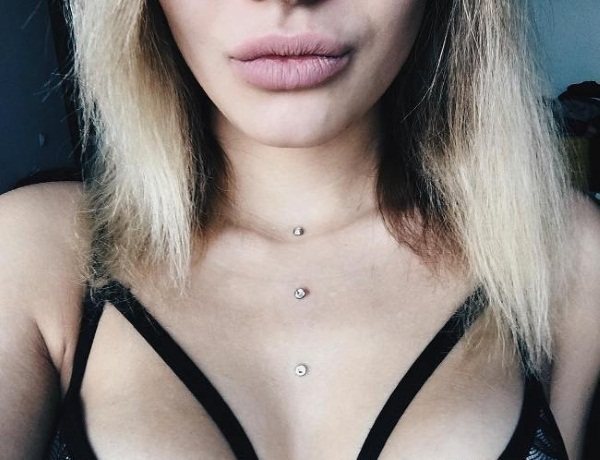

The area above the breast is comfortable, but it is not a good option for piercing, because here the skin is delicate, which is prone to trauma at the stage of healing of the incision.
The microdermal in this setting is most often in contact with clothing, which in the fall, winter and spring seasons is tight to the body. Given these serious reasons, the jewelry should be kept to a minimum size.
Body modifications with play piercings
Play piercings - Is a special subspecies of body art. Its main difference from the countless other types is that it is not left in the body permanently (or permanently). Often it is performed for certain events or a short period of self-affirmation. Play piercing - implantation under the skin of different foreign objects in huge numbers with numerous punctures. This is decorating the back, fingers of the hand, wrist and stomach with ribbons and beads, installing pins in the skin, etc.
Even among the experienced "piercingists" there are quite a few people who dare to wear similar decorations for more than one day. It is not only uncomfortable, but also very painful. Among fans of extreme body art, corset and smiley face compositions are especially popular. True, many specialized salons offer to do even more difficult combinations of elements.
Does it hurt to do the procedure
Microdermal on the neck (photo of a professional installation is shown above), face, arm, chest, collarbone, lower back is carried out without painkillers. The piercing, mounting of the structure is tolerated differently by the girls.
To a large extent, the painful sensations are influenced by:
- the place of insertion of the anchor;
- The presence of practical knowledge and skills of the master;
- Each person's pain threshold is different.

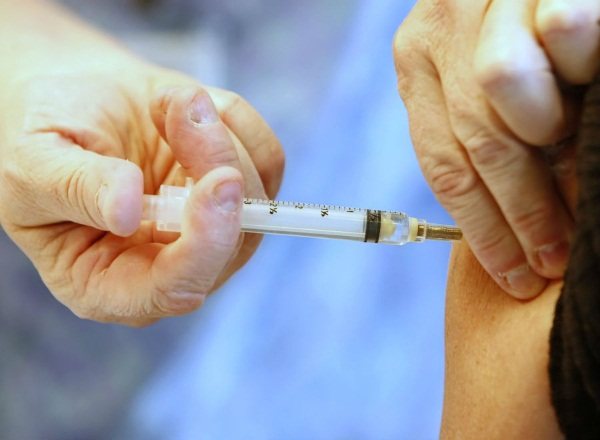
If the client wishes to use an anesthetic, the master will not ignore her wish. Although the technology is so advanced that the procedure lasts only about 3 minutes without blood and injury. In comparison, waxing hairs feels more painful.
Specialists say that wound healing is associated with the use of anesthesia, in which medications fall into a kind of pocket under the skin, prepared for the introduction of the plate. This situation complicates the healing process.
Microdermal implantation zones
The most convenient location of the jewelry is on the chest. In such an arrangement, the flat piercing will not cling to clothing and, if necessary, it will be easily hidden.
Clavicle piercings are often placed symmetrically near the bones themselves.
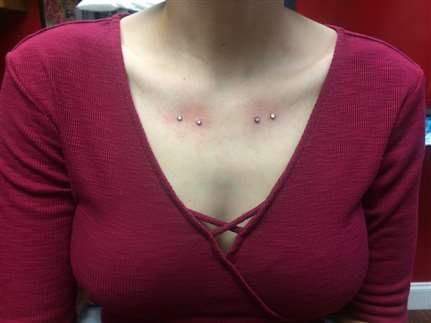

Or along one of them.
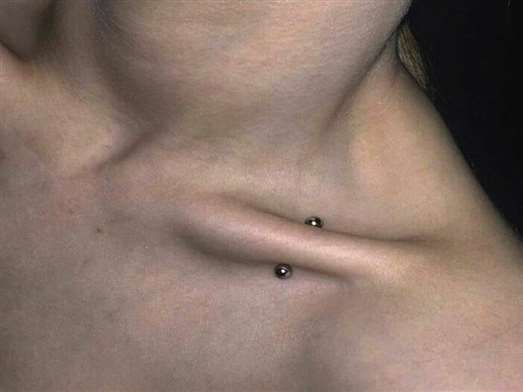

This piercing looks through, but in fact it is two different earrings.
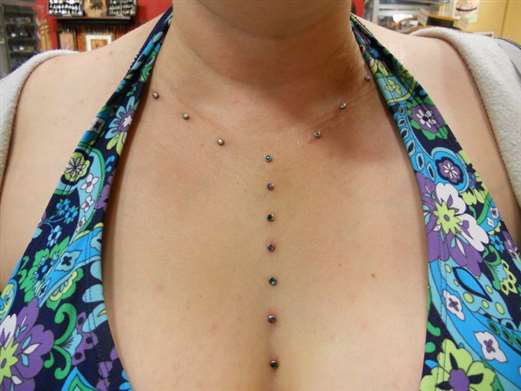

Necklace made of small microdermals.
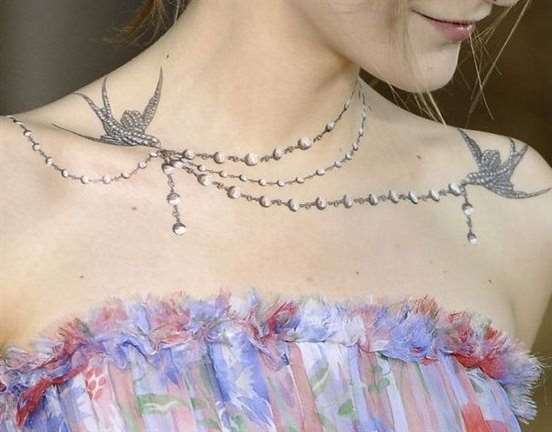

A necklace combined with a tattoo.
How long does a microdermal heal
Usually the wound after a microdermal on the body heals for six months, sometimes a year.
If the healing takes a long time, then there are reasons for this:
- Inflammatory process;
- damage to the skin's stratum corneum;
- Trauma to the muscle tissue.
If at least one of these serious causes is present, the regenerative process is stalled. Masters are advised to treat dermals as temporary jewelry, but in some cases, the implant remains in the body for an extended period before it is removed on its own.
Possible consequences
Microdermal, like any type of piercing, is a minor surgical procedure, which means that it entails certain complications.
The consequences of implanting an earring inside the skin:
- The jewelry will not take root and rejection will occur. To reduce this risk will help to choose the correct product of hypoallergenic material.
- Risk of infection and blood poisoning. Danger haunts salons, where the sterility of instruments is not respected, and in the subsequent care if the rules of treatment are violated.
- After removal of the earring, a scar remains in the place where it is placed. To ensure that the mark from the microdermal on the clavicles remains unnoticeable, the procedure should be performed by a master who will carefully remove the plate from the layers of skin.
Before the implantation of a flat piercing, it is necessary to carefully analyze possible complications and try to reduce the risk of their development.
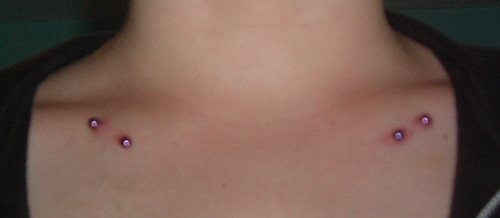

Care of the product and the implantation site
During the healing of any wound, including the installation of a microdermal, it is necessary to adhere to certain rules:
- Do not interfere with the body's recovery process by damaging the incision.
- Ensure cleanliness. No dust or dirt should enter the wound.

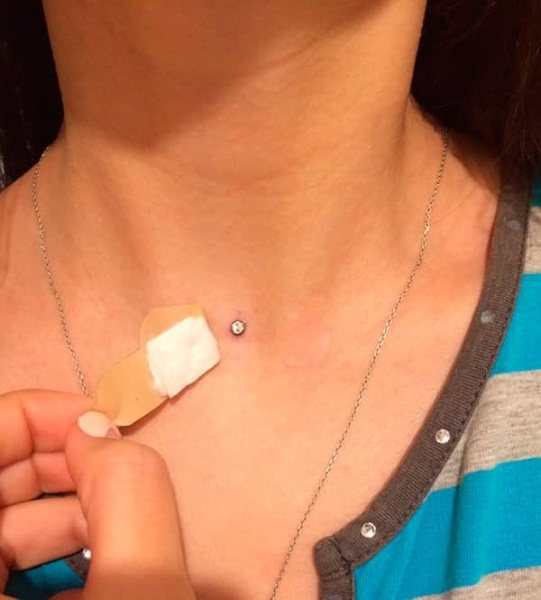
To do this, you need to have in your possession:
- antiseptic (Miramistin);
- an aqueous solution of sodium chloride to rinse it out;
- plaster.
Cleaning of the skin and dermal from secretions and crusts formed is carried out with saline solution:
- The product to be treated is loaded into the solution for 3 minutes.
- The skin should be cleaned very carefully, without touching the puncture with a cotton swab.
- At the end of the procedure the solution should be rinsed off with clean water.
To treat with an antiseptic (Miramistin), a gauze cloth or tampon is moistened and applied to the anchor site for a couple of minutes. The purpose of the lotion is to disinfect the skin.
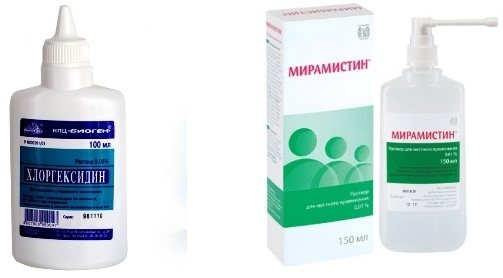

For the first 2 weeks, daily:
- Wash the implant with a decontaminating solution.
- Use the shepherd before going to bed and before going outdoors.
Up to three months:
- The incision site should be washed 1-2 times a day with a weak soapy solution.
- Protect the tresses from possible friction or pressure with a band-aid.
After three months to one year:
- Wash the dermal periodically, inspecting the puncture site on the skin for inflammation.
- You can try to change the twist on your own.
Installation Features
Installation of microdermal always takes place according to a clear order. The first thing that is done is an antiseptic treatment of the instruments and the area of the skin on which the jewelry will be placed. Next, the master makes a scalpel incision in the skin itself and an incision in two directions under it, separating the skin from the fatty tissue (in the place where the plate is attached).
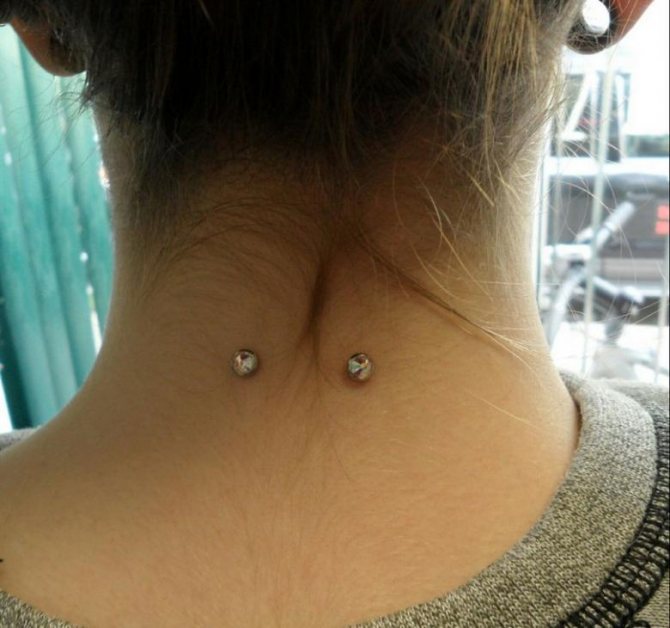

An anchor is inserted into this hole (it is recommended to do it the first time) and the tip that fixes the jewelry is screwed on. After all manipulations necessarily piercing glued plaster to avoid dirt and dust.
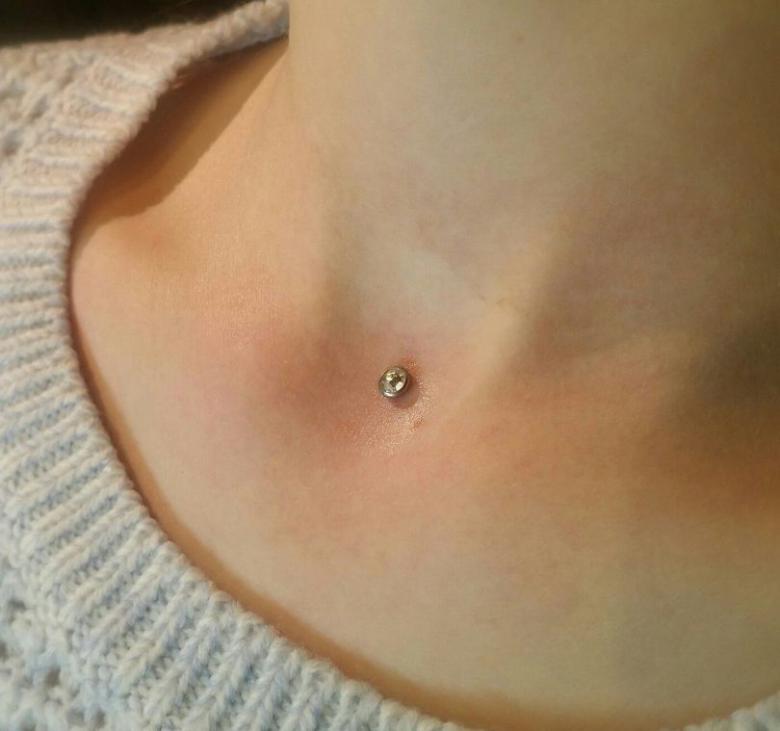

Consequences and possible complications
After the initial period after the implantation of microdermal already passed, it is important to continue to be careful not to damage the full recovery of the skin.
But during this time, it is recommended to refrain
- From alcohol and tobacco products;
- Stay away from the solarium for two weeks;
- From swimming pools for 4 weeks;
- from sauna and bathing for up to 2 months.
- on the recommendation of a specialist, exclude certain medications (including Aspirin);
- It is advisable not to use cosmetics, varnishes.
The greatest danger is caused by:
- development of infection in the puncture site;
- formation of scars;
- rejection of the implant.
Infection can be detected by signs:
- redness in the incision area;
- pus has formed;
- pain or itching increases;
- Increased body temperature;
- symptomatic headache, feeling of weakness.
If these symptoms occur, you should consult a specialist (dermatologist, surgeon). In rare cases, it is necessary to remove the dermal.
Possible complications
Like any piercing, clavicle microdermal is a small, but still an operation, and any violation of the integrity of the skin can entail certain consequences. But given that microdermal damages the skin to a lesser extent than traditional piercings, it causes fewer complications. These include:
- The possibility of infection. The risk especially increases if the procedure is done in dubious tattoo parlors or even at home. In addition, you can get an infection if you twist, pull or play with the jewelry during the recovery period.
- Possibility of rejection of the jewelry. If you use a piece of jewelry made of unsuitable material - plastic, medical alloy or low-quality steel, your skin may not accept this new growth inside itself. Then there will be quite unpleasant feelings, and the jewelry will begin to "push" outward. In this case, it will be necessary to remove it by contacting a piercer.
- The removal of the jewelry will leave a scar. If you decide to remove the jewelry permanently (only a piercer can do this), at first there will be a small hole in its place. It will gradually fade, but an attentive eye will still notice the scar.
If the procedure is performed in a reliable salon by an experienced master, and then properly care for the piercing, there should be no complications. The price for clavicle piercing varies in each salon, but usually ranges around 1500-2000 rubles.
Before the procedure, be sure to consider all the pros and cons, so as not to regret the loss of effort and money later. The consequences, to which the clavicle piercing can lead are rather unpleasant, but not dangerous. At the same time, microdermal in the collarbone area will attract to you a well-deserved attention and make your personality brighter.
How to remove the dermal
Specialists advise to think well, assess the advantages and disadvantages of the jewelry to each person on the eve of the first installation. Installation and removal of the jewelry is carried out in specialized salons or specially equipped clinics in sterile conditions.
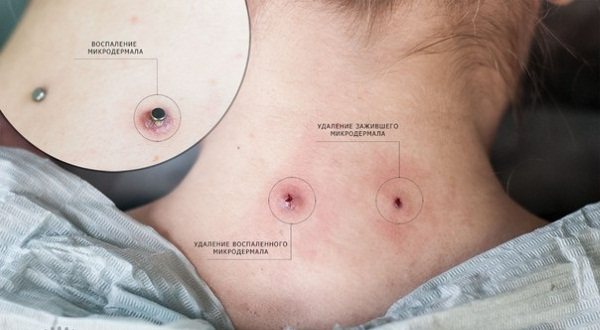

It is not recommended to remove the microdermal yourself, because it is dangerous because it will leave a scar on the neck or other visible part of the body. You can entrust the procedure of removing the base without formation of scars and scars to an experienced master. Only photographs and memory will preserve the moments with the jewelry on the body.
Article design: Vladimir the Great
Care after flat piercing
Like other types of minimally invasive interventions, microdermal clavicle requires careful care for the wound and compliance with the rules of hygiene. Any violation is fraught with complications. To avoid negative consequences and speed up healing in the implant area, the following requirements must be observed.
- The plaster must be kept on for 2-3 days after the procedure.
- For the first 24 hours after inserting the implant, you should avoid contact with water.
- It is forbidden to take a bath, swim in the pool, river or sea, go to the sauna until the healing is complete.
- It is not recommended to remove the decorative element until the healing of the implant.
- Until the wound is completely healed, you should treat it with antiseptic twice a day.
- Until the wound heals, it is desirable to minimize the contact of the microdermal with clothing elements.
Flat piercings heal more slowly than earlobe or belly button piercings. This is due to the area where the jewelry is placed. In the neck area, the skin is thinner and more sensitive, it is constantly in contact with clothing, bed linen, which increases the risk of trauma and infection.
While the incision is healing, any exposure that increases the risk of infection should be avoided. Only warm, but not hot showers are allowed to maintain body hygiene. Bathing in any body of water is forbidden. It is advisable to avoid intense physical activity accompanied by intense sweating.
It is very important to use special antiseptic means for disinfecting wounds in the microdermal area. It is desirable not to use alcohol-containing solutions, but to treat the area with chlorhexidine, myrmistine or hydrogen peroxide.
The healing time and integration of the metal plate varies from person to person. On average, it takes 2-3 weeks for the tissue to fully recover.
